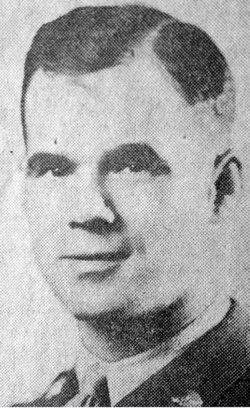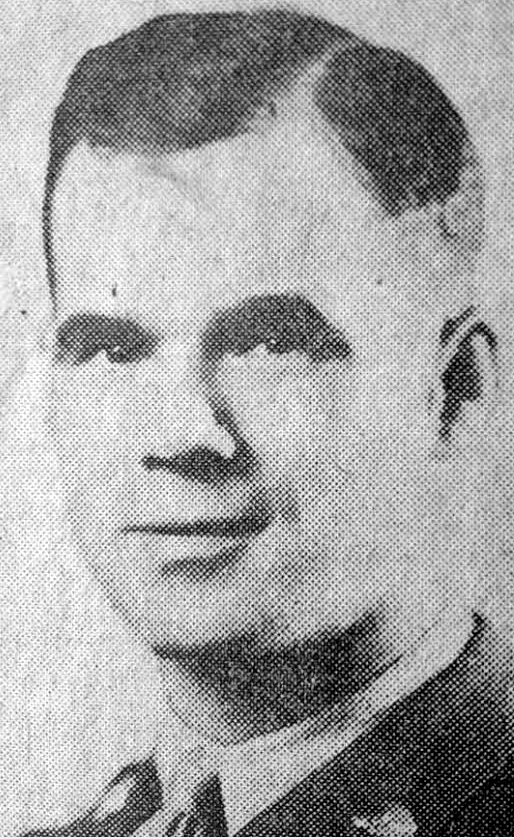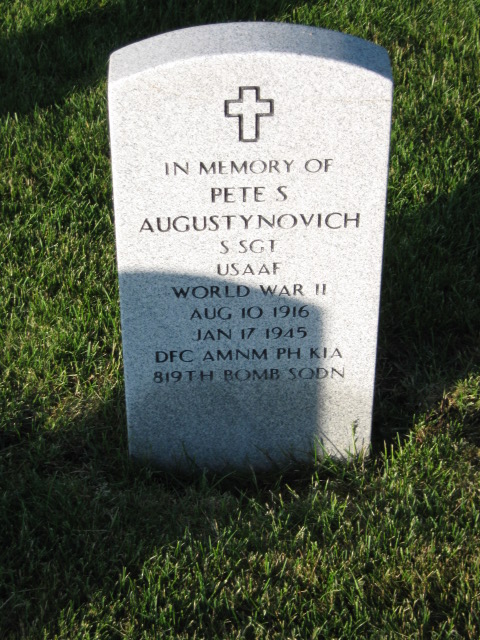Awards: Distinguished Flying Cross, Air Medal with 2 Oak Leaf Clusters, Purple Heart
In June of 2004, a memorial service was held for him at Western Reserve Cemetery in Rittman, Ohio and a marker placed.
*************
Information extracted from the official Missing Air Crew Report
Point of Departure: Isley Field #2, Saipan
Target: Iwo Jima
Aircraft lost as result of: Enemy Anti-Aircraft
Aircraft Info: B-24J, R-1830-65 "Hell from Heaven"
Division: 819th Bomber Squadron, 30th Bomber Group, Heavy
*************
Statement by 1st Lt. Stanley C. Lewis, 0434293, on the "ditching" of Airplane B-24J 44-40528 on 17 Jan 1945.
Immediately after "bombs away" at 1647 from our formation, we received the call that 28V373 with Lt. Painter and crew, had one engine out and was having trouble with two others. We lost altitude rapidly and stayed to one side and just above him for about twenty minutes.
Lt. Painter jettisoned his ball turret and other items from the airplane but could not maintain altitude. The airplane hit the water at 1723K. The plane landed perfectly and one life raft on each side came to float.
We circled in our plane and threw out two life rafts to them on the first pass, and saw seven (7) men in the water with life vests on. We continued to circle them and threw out to them on (1) jungle first aid kit, one (1) airplane first aid kit, rope, Gibson-Girl, two (2) A-2 leather jackets, six (6) winter flying jackets, three (3) winter flying trousers, and emergency rations of water.
In the meantime two (2) life rafts were righted, however, as time went on the life rafts drifted away from the men, and at no time was anyone seen in the rafts.
We had thrown several dye markers out, and they were showing up well in the water.
As time went on, fewer individuals were seen, however, it was getting dark, and visibility was lessened, so we cannot say that the men had gone under.
Lt. Knudson, in airplane 08V373, stayed with Lt. Painter in a similar manner, and he also threw out much equipment to the men in the water.
Stanley C. Lewis, 0434293
1st Lt. Air Corps.
*************
Statement by 1st Lt Arthur M. Knudson, 0757219, on the "ditching" of Airplane B-24J 44-40528 on 17 Jan 1945.
At 1205K, 17 January 1945, the first of fourteen airplanes took off on a combat strike mission on Iwo Jima. Lt. Painter and crew, in airplane No. 528, was leading "D" Flight when their plane was hit by flak at 1644K. The hydraulics system was shot out. No. 4 engine had to be feathered, and Nos. 2 and 3 engines registered only 23 inches M.P. at medium altitude. They were losing altitude rapidly at an air speed of 125 M.P.H., and proceeded to toss out heavy equipment including the ball turret, which was jettisoned at 1,000 feet.
It became necessary to "ditch" the airplane at 1724K. The landing was made "flaps up" in calm water. After the first contact with the water, the plane skimmed along the surface, putting out an even spray for about 300 to 500 feet. It then nosed into the ocean and made a sudden stop, within about 100 feet, sending up a geyser of water. The plane then submerged completely, but a few seconds later it rose to the surface. It broke in two just aft of the wings. The nose and engines were completely submerged with the trailing edge of the wings rising out of the water at a 90 degree angle. The tail section was only partially afloat until the plane sank, ten minutes after ditching.
Five (5) survivors, wearing Mae Wests, were sighted near the wreckage; four (4) of which were motionless in the water, one of the four thought to be copilot, Lt. Nelson. He was floating a few feet in front of the plane. The fifth survivor was identified by several of our crew as S/Sgt Boggs. He waved at our plane as we made our first pass, but appeared to be inactive during the succeeding passes.
We dropped two (2) life rafts.
Although six rafts were floating, all were empty when we left, one hour later. The survivors made no visible attempts to get into the life rafts.
Arthur M. Knudson, 0757219
1st Lt., Air Corps.
*************
Link to Staff Sgt. Augustynovich's memorial in Honolulu:
Tablets of the Missing at Honolulu Memorial
*************
Awards: Distinguished Flying Cross, Air Medal with 2 Oak Leaf Clusters, Purple Heart
In June of 2004, a memorial service was held for him at Western Reserve Cemetery in Rittman, Ohio and a marker placed.
*************
Information extracted from the official Missing Air Crew Report
Point of Departure: Isley Field #2, Saipan
Target: Iwo Jima
Aircraft lost as result of: Enemy Anti-Aircraft
Aircraft Info: B-24J, R-1830-65 "Hell from Heaven"
Division: 819th Bomber Squadron, 30th Bomber Group, Heavy
*************
Statement by 1st Lt. Stanley C. Lewis, 0434293, on the "ditching" of Airplane B-24J 44-40528 on 17 Jan 1945.
Immediately after "bombs away" at 1647 from our formation, we received the call that 28V373 with Lt. Painter and crew, had one engine out and was having trouble with two others. We lost altitude rapidly and stayed to one side and just above him for about twenty minutes.
Lt. Painter jettisoned his ball turret and other items from the airplane but could not maintain altitude. The airplane hit the water at 1723K. The plane landed perfectly and one life raft on each side came to float.
We circled in our plane and threw out two life rafts to them on the first pass, and saw seven (7) men in the water with life vests on. We continued to circle them and threw out to them on (1) jungle first aid kit, one (1) airplane first aid kit, rope, Gibson-Girl, two (2) A-2 leather jackets, six (6) winter flying jackets, three (3) winter flying trousers, and emergency rations of water.
In the meantime two (2) life rafts were righted, however, as time went on the life rafts drifted away from the men, and at no time was anyone seen in the rafts.
We had thrown several dye markers out, and they were showing up well in the water.
As time went on, fewer individuals were seen, however, it was getting dark, and visibility was lessened, so we cannot say that the men had gone under.
Lt. Knudson, in airplane 08V373, stayed with Lt. Painter in a similar manner, and he also threw out much equipment to the men in the water.
Stanley C. Lewis, 0434293
1st Lt. Air Corps.
*************
Statement by 1st Lt Arthur M. Knudson, 0757219, on the "ditching" of Airplane B-24J 44-40528 on 17 Jan 1945.
At 1205K, 17 January 1945, the first of fourteen airplanes took off on a combat strike mission on Iwo Jima. Lt. Painter and crew, in airplane No. 528, was leading "D" Flight when their plane was hit by flak at 1644K. The hydraulics system was shot out. No. 4 engine had to be feathered, and Nos. 2 and 3 engines registered only 23 inches M.P. at medium altitude. They were losing altitude rapidly at an air speed of 125 M.P.H., and proceeded to toss out heavy equipment including the ball turret, which was jettisoned at 1,000 feet.
It became necessary to "ditch" the airplane at 1724K. The landing was made "flaps up" in calm water. After the first contact with the water, the plane skimmed along the surface, putting out an even spray for about 300 to 500 feet. It then nosed into the ocean and made a sudden stop, within about 100 feet, sending up a geyser of water. The plane then submerged completely, but a few seconds later it rose to the surface. It broke in two just aft of the wings. The nose and engines were completely submerged with the trailing edge of the wings rising out of the water at a 90 degree angle. The tail section was only partially afloat until the plane sank, ten minutes after ditching.
Five (5) survivors, wearing Mae Wests, were sighted near the wreckage; four (4) of which were motionless in the water, one of the four thought to be copilot, Lt. Nelson. He was floating a few feet in front of the plane. The fifth survivor was identified by several of our crew as S/Sgt Boggs. He waved at our plane as we made our first pass, but appeared to be inactive during the succeeding passes.
We dropped two (2) life rafts.
Although six rafts were floating, all were empty when we left, one hour later. The survivors made no visible attempts to get into the life rafts.
Arthur M. Knudson, 0757219
1st Lt., Air Corps.
*************
Link to Staff Sgt. Augustynovich's memorial in Honolulu:
Tablets of the Missing at Honolulu Memorial
*************










